CMNS 130: Advertising as the Primary Ideology in Capitalist Societies
VerifiedAdded on 2022/08/21
|10
|2663
|13
Essay
AI Summary
This essay argues that advertising serves as a central ideology in capitalist societies by influencing public perception, reinforcing socio-political arrangements, and promoting consumerism. It discusses various advertising methods, including digital, print, and public service advertising, and analyzes the ideologies and values associated with them, such as the creation of class differences and the use of celebrity endorsements. The essay also examines the ethical considerations and commercial strategies behind advertising, advocating for a more responsible and ethical approach that prioritizes social well-being over manipulative tactics. Furthermore, it explores the relationship between capitalism and advertising, highlighting how advertising promotes material ambitions and virtues of private life while legitimizing capitalist realism and fetishism of commodities. Ultimately, the essay concludes that advertising plays a significant role in shaping consumer behavior and reinforcing the capitalist ideology.
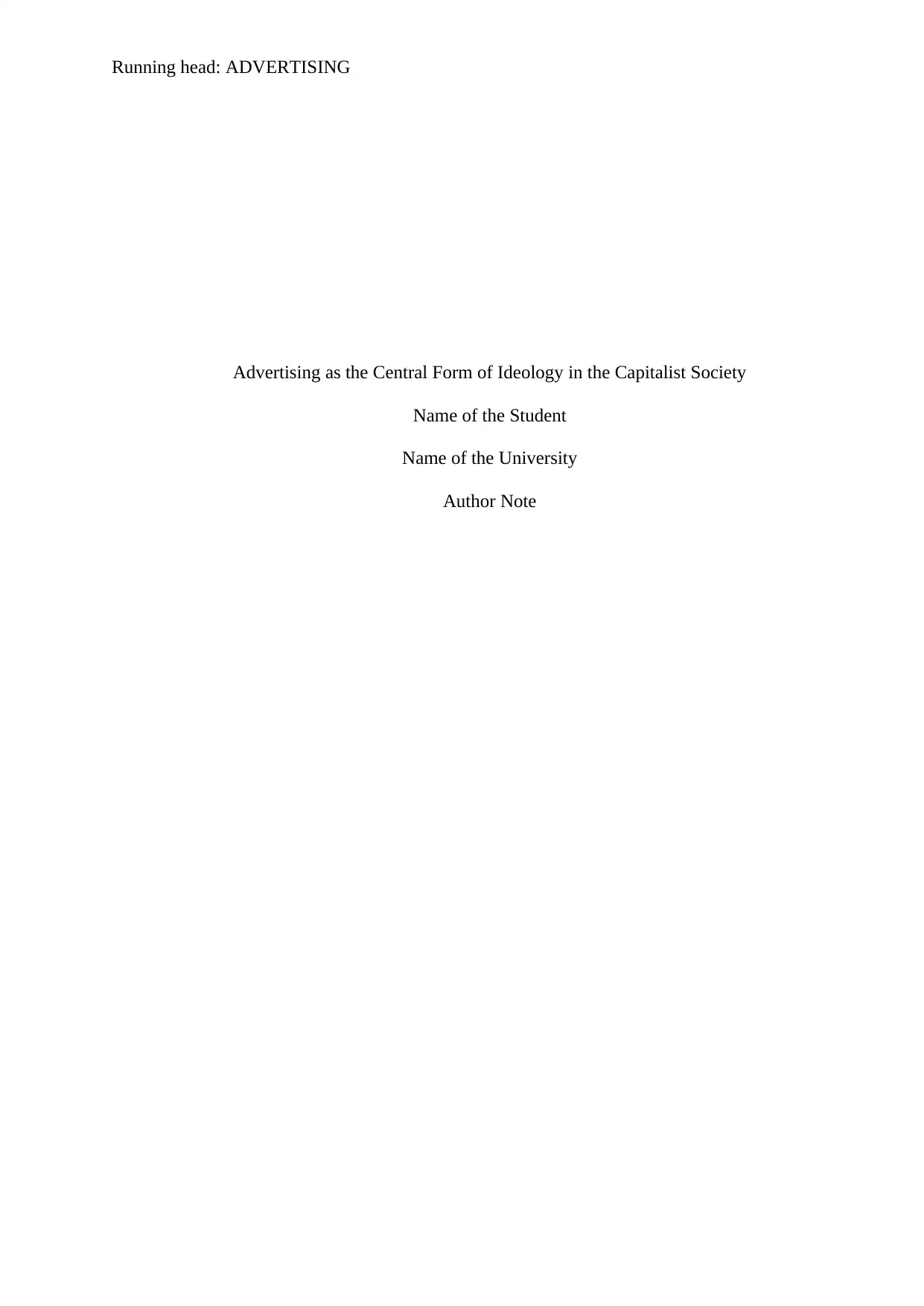
Running head: ADVERTISING
Advertising as the Central Form of Ideology in the Capitalist Society
Name of the Student
Name of the University
Author Note
Advertising as the Central Form of Ideology in the Capitalist Society
Name of the Student
Name of the University
Author Note
Paraphrase This Document
Need a fresh take? Get an instant paraphrase of this document with our AI Paraphraser
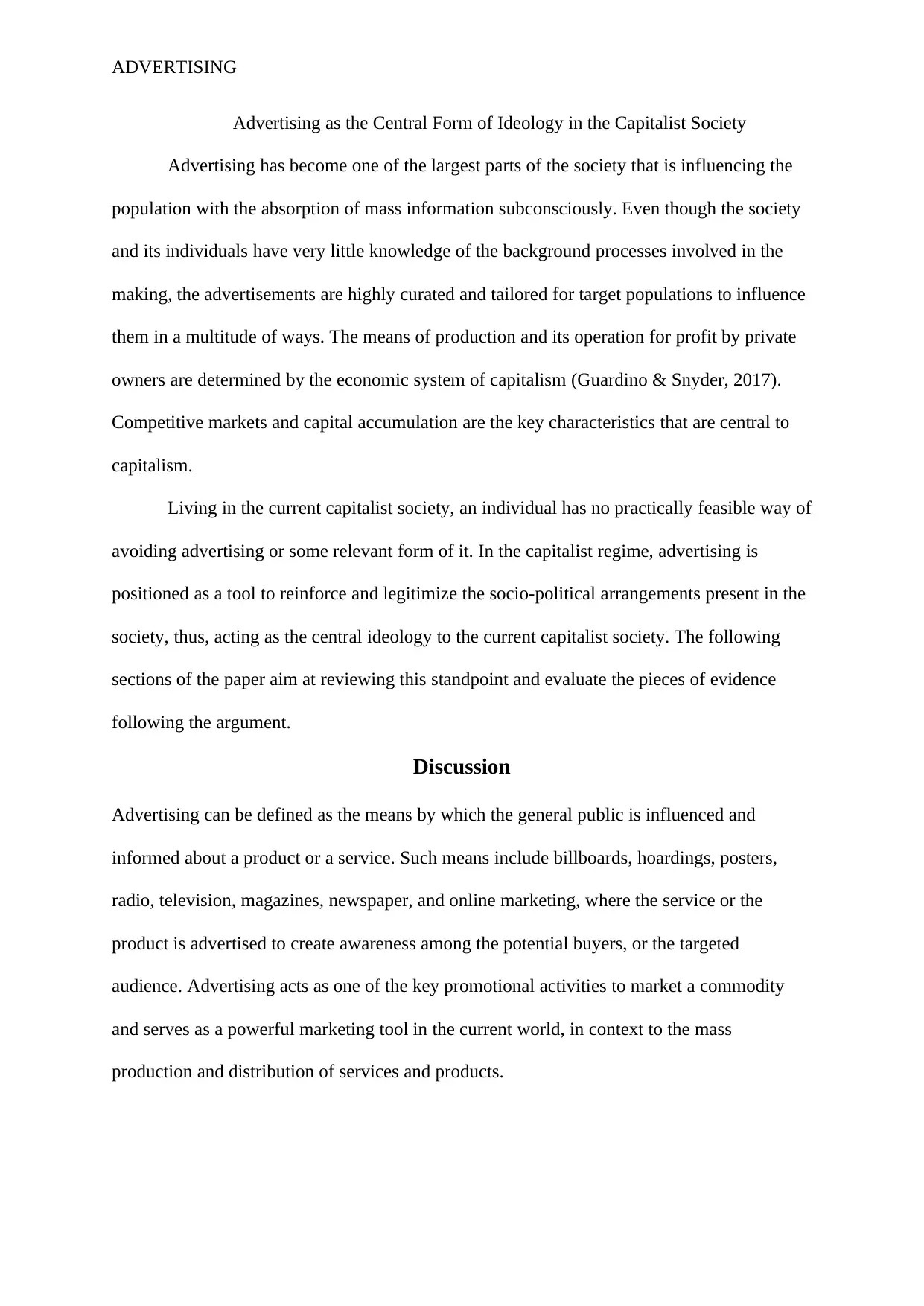
ADVERTISING
Advertising as the Central Form of Ideology in the Capitalist Society
Advertising has become one of the largest parts of the society that is influencing the
population with the absorption of mass information subconsciously. Even though the society
and its individuals have very little knowledge of the background processes involved in the
making, the advertisements are highly curated and tailored for target populations to influence
them in a multitude of ways. The means of production and its operation for profit by private
owners are determined by the economic system of capitalism (Guardino & Snyder, 2017).
Competitive markets and capital accumulation are the key characteristics that are central to
capitalism.
Living in the current capitalist society, an individual has no practically feasible way of
avoiding advertising or some relevant form of it. In the capitalist regime, advertising is
positioned as a tool to reinforce and legitimize the socio-political arrangements present in the
society, thus, acting as the central ideology to the current capitalist society. The following
sections of the paper aim at reviewing this standpoint and evaluate the pieces of evidence
following the argument.
Discussion
Advertising can be defined as the means by which the general public is influenced and
informed about a product or a service. Such means include billboards, hoardings, posters,
radio, television, magazines, newspaper, and online marketing, where the service or the
product is advertised to create awareness among the potential buyers, or the targeted
audience. Advertising acts as one of the key promotional activities to market a commodity
and serves as a powerful marketing tool in the current world, in context to the mass
production and distribution of services and products.
Advertising as the Central Form of Ideology in the Capitalist Society
Advertising has become one of the largest parts of the society that is influencing the
population with the absorption of mass information subconsciously. Even though the society
and its individuals have very little knowledge of the background processes involved in the
making, the advertisements are highly curated and tailored for target populations to influence
them in a multitude of ways. The means of production and its operation for profit by private
owners are determined by the economic system of capitalism (Guardino & Snyder, 2017).
Competitive markets and capital accumulation are the key characteristics that are central to
capitalism.
Living in the current capitalist society, an individual has no practically feasible way of
avoiding advertising or some relevant form of it. In the capitalist regime, advertising is
positioned as a tool to reinforce and legitimize the socio-political arrangements present in the
society, thus, acting as the central ideology to the current capitalist society. The following
sections of the paper aim at reviewing this standpoint and evaluate the pieces of evidence
following the argument.
Discussion
Advertising can be defined as the means by which the general public is influenced and
informed about a product or a service. Such means include billboards, hoardings, posters,
radio, television, magazines, newspaper, and online marketing, where the service or the
product is advertised to create awareness among the potential buyers, or the targeted
audience. Advertising acts as one of the key promotional activities to market a commodity
and serves as a powerful marketing tool in the current world, in context to the mass
production and distribution of services and products.
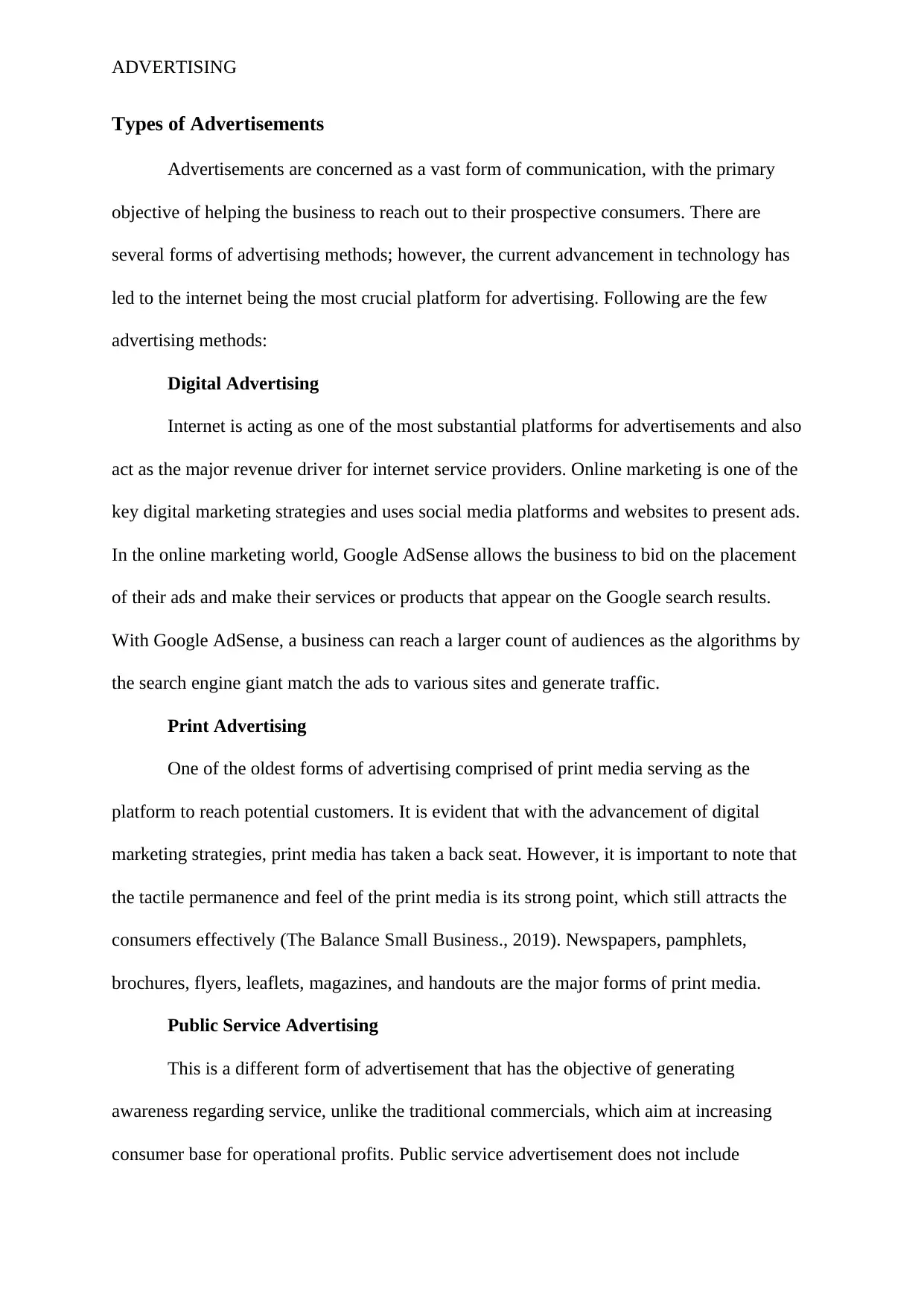
ADVERTISING
Types of Advertisements
Advertisements are concerned as a vast form of communication, with the primary
objective of helping the business to reach out to their prospective consumers. There are
several forms of advertising methods; however, the current advancement in technology has
led to the internet being the most crucial platform for advertising. Following are the few
advertising methods:
Digital Advertising
Internet is acting as one of the most substantial platforms for advertisements and also
act as the major revenue driver for internet service providers. Online marketing is one of the
key digital marketing strategies and uses social media platforms and websites to present ads.
In the online marketing world, Google AdSense allows the business to bid on the placement
of their ads and make their services or products that appear on the Google search results.
With Google AdSense, a business can reach a larger count of audiences as the algorithms by
the search engine giant match the ads to various sites and generate traffic.
Print Advertising
One of the oldest forms of advertising comprised of print media serving as the
platform to reach potential customers. It is evident that with the advancement of digital
marketing strategies, print media has taken a back seat. However, it is important to note that
the tactile permanence and feel of the print media is its strong point, which still attracts the
consumers effectively (The Balance Small Business., 2019). Newspapers, pamphlets,
brochures, flyers, leaflets, magazines, and handouts are the major forms of print media.
Public Service Advertising
This is a different form of advertisement that has the objective of generating
awareness regarding service, unlike the traditional commercials, which aim at increasing
consumer base for operational profits. Public service advertisement does not include
Types of Advertisements
Advertisements are concerned as a vast form of communication, with the primary
objective of helping the business to reach out to their prospective consumers. There are
several forms of advertising methods; however, the current advancement in technology has
led to the internet being the most crucial platform for advertising. Following are the few
advertising methods:
Digital Advertising
Internet is acting as one of the most substantial platforms for advertisements and also
act as the major revenue driver for internet service providers. Online marketing is one of the
key digital marketing strategies and uses social media platforms and websites to present ads.
In the online marketing world, Google AdSense allows the business to bid on the placement
of their ads and make their services or products that appear on the Google search results.
With Google AdSense, a business can reach a larger count of audiences as the algorithms by
the search engine giant match the ads to various sites and generate traffic.
Print Advertising
One of the oldest forms of advertising comprised of print media serving as the
platform to reach potential customers. It is evident that with the advancement of digital
marketing strategies, print media has taken a back seat. However, it is important to note that
the tactile permanence and feel of the print media is its strong point, which still attracts the
consumers effectively (The Balance Small Business., 2019). Newspapers, pamphlets,
brochures, flyers, leaflets, magazines, and handouts are the major forms of print media.
Public Service Advertising
This is a different form of advertisement that has the objective of generating
awareness regarding service, unlike the traditional commercials, which aim at increasing
consumer base for operational profits. Public service advertisement does not include
⊘ This is a preview!⊘
Do you want full access?
Subscribe today to unlock all pages.

Trusted by 1+ million students worldwide
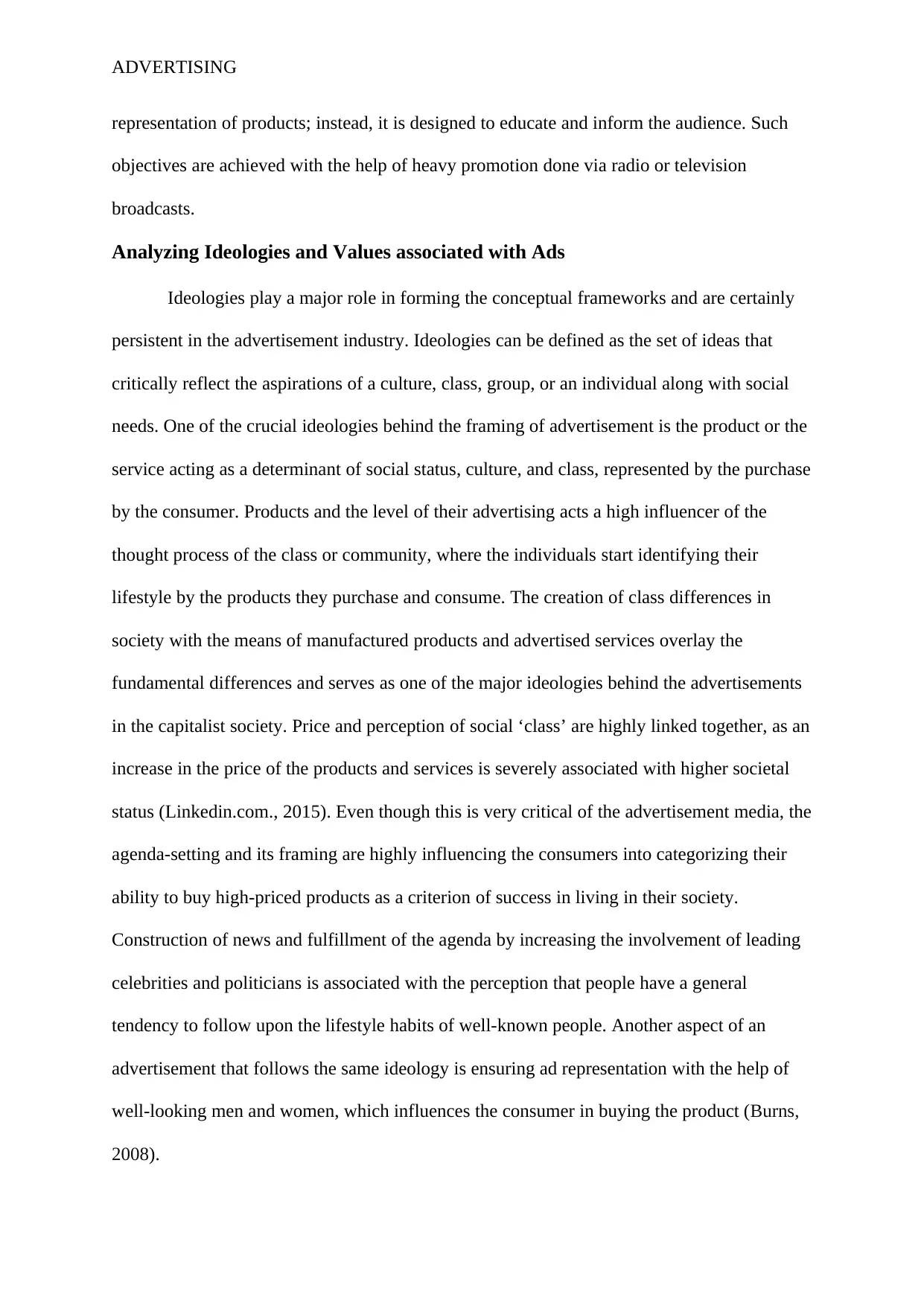
ADVERTISING
representation of products; instead, it is designed to educate and inform the audience. Such
objectives are achieved with the help of heavy promotion done via radio or television
broadcasts.
Analyzing Ideologies and Values associated with Ads
Ideologies play a major role in forming the conceptual frameworks and are certainly
persistent in the advertisement industry. Ideologies can be defined as the set of ideas that
critically reflect the aspirations of a culture, class, group, or an individual along with social
needs. One of the crucial ideologies behind the framing of advertisement is the product or the
service acting as a determinant of social status, culture, and class, represented by the purchase
by the consumer. Products and the level of their advertising acts a high influencer of the
thought process of the class or community, where the individuals start identifying their
lifestyle by the products they purchase and consume. The creation of class differences in
society with the means of manufactured products and advertised services overlay the
fundamental differences and serves as one of the major ideologies behind the advertisements
in the capitalist society. Price and perception of social ‘class’ are highly linked together, as an
increase in the price of the products and services is severely associated with higher societal
status (Linkedin.com., 2015). Even though this is very critical of the advertisement media, the
agenda-setting and its framing are highly influencing the consumers into categorizing their
ability to buy high-priced products as a criterion of success in living in their society.
Construction of news and fulfillment of the agenda by increasing the involvement of leading
celebrities and politicians is associated with the perception that people have a general
tendency to follow upon the lifestyle habits of well-known people. Another aspect of an
advertisement that follows the same ideology is ensuring ad representation with the help of
well-looking men and women, which influences the consumer in buying the product (Burns,
2008).
representation of products; instead, it is designed to educate and inform the audience. Such
objectives are achieved with the help of heavy promotion done via radio or television
broadcasts.
Analyzing Ideologies and Values associated with Ads
Ideologies play a major role in forming the conceptual frameworks and are certainly
persistent in the advertisement industry. Ideologies can be defined as the set of ideas that
critically reflect the aspirations of a culture, class, group, or an individual along with social
needs. One of the crucial ideologies behind the framing of advertisement is the product or the
service acting as a determinant of social status, culture, and class, represented by the purchase
by the consumer. Products and the level of their advertising acts a high influencer of the
thought process of the class or community, where the individuals start identifying their
lifestyle by the products they purchase and consume. The creation of class differences in
society with the means of manufactured products and advertised services overlay the
fundamental differences and serves as one of the major ideologies behind the advertisements
in the capitalist society. Price and perception of social ‘class’ are highly linked together, as an
increase in the price of the products and services is severely associated with higher societal
status (Linkedin.com., 2015). Even though this is very critical of the advertisement media, the
agenda-setting and its framing are highly influencing the consumers into categorizing their
ability to buy high-priced products as a criterion of success in living in their society.
Construction of news and fulfillment of the agenda by increasing the involvement of leading
celebrities and politicians is associated with the perception that people have a general
tendency to follow upon the lifestyle habits of well-known people. Another aspect of an
advertisement that follows the same ideology is ensuring ad representation with the help of
well-looking men and women, which influences the consumer in buying the product (Burns,
2008).
Paraphrase This Document
Need a fresh take? Get an instant paraphrase of this document with our AI Paraphraser
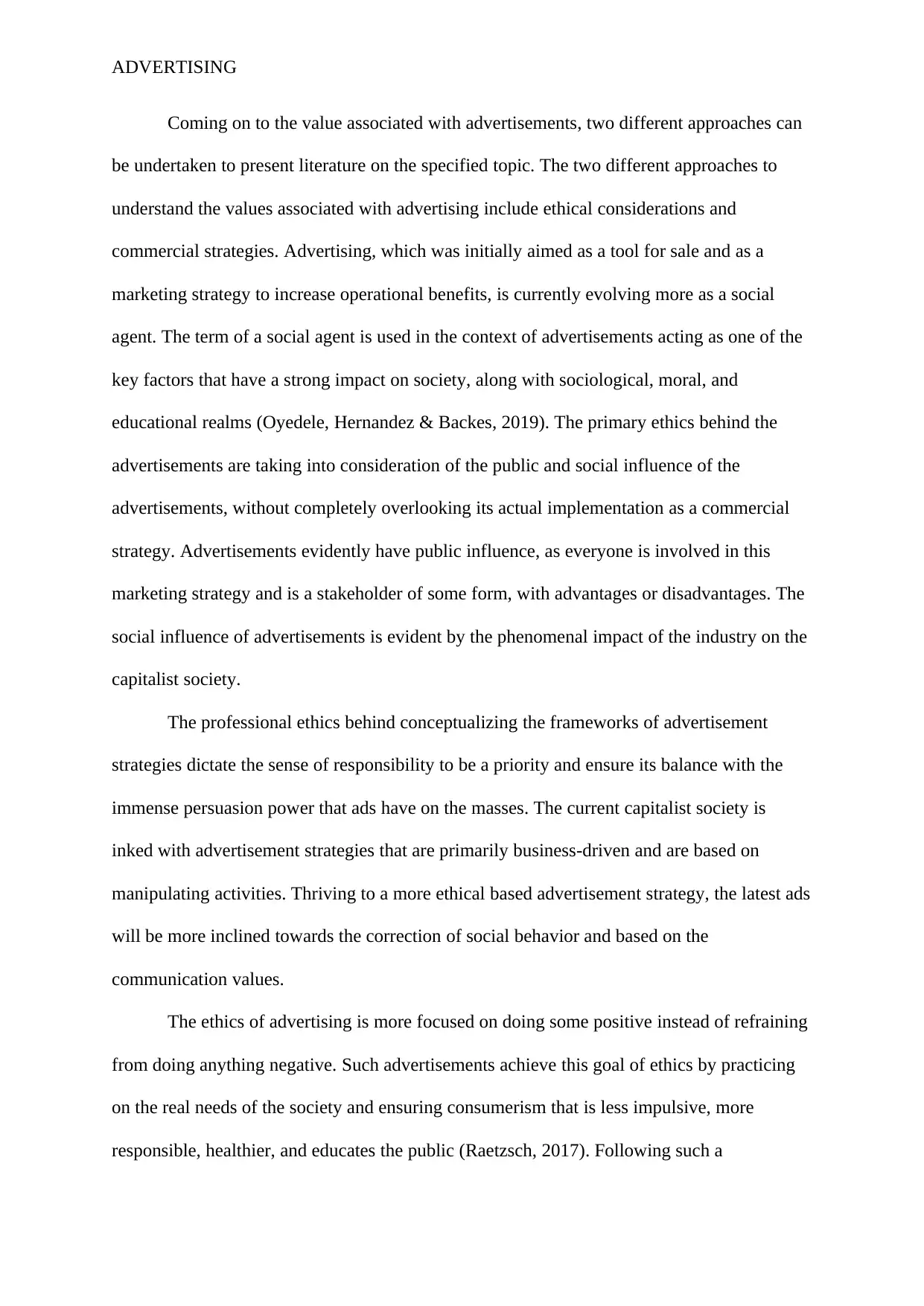
ADVERTISING
Coming on to the value associated with advertisements, two different approaches can
be undertaken to present literature on the specified topic. The two different approaches to
understand the values associated with advertising include ethical considerations and
commercial strategies. Advertising, which was initially aimed as a tool for sale and as a
marketing strategy to increase operational benefits, is currently evolving more as a social
agent. The term of a social agent is used in the context of advertisements acting as one of the
key factors that have a strong impact on society, along with sociological, moral, and
educational realms (Oyedele, Hernandez & Backes, 2019). The primary ethics behind the
advertisements are taking into consideration of the public and social influence of the
advertisements, without completely overlooking its actual implementation as a commercial
strategy. Advertisements evidently have public influence, as everyone is involved in this
marketing strategy and is a stakeholder of some form, with advantages or disadvantages. The
social influence of advertisements is evident by the phenomenal impact of the industry on the
capitalist society.
The professional ethics behind conceptualizing the frameworks of advertisement
strategies dictate the sense of responsibility to be a priority and ensure its balance with the
immense persuasion power that ads have on the masses. The current capitalist society is
inked with advertisement strategies that are primarily business-driven and are based on
manipulating activities. Thriving to a more ethical based advertisement strategy, the latest ads
will be more inclined towards the correction of social behavior and based on the
communication values.
The ethics of advertising is more focused on doing some positive instead of refraining
from doing anything negative. Such advertisements achieve this goal of ethics by practicing
on the real needs of the society and ensuring consumerism that is less impulsive, more
responsible, healthier, and educates the public (Raetzsch, 2017). Following such a
Coming on to the value associated with advertisements, two different approaches can
be undertaken to present literature on the specified topic. The two different approaches to
understand the values associated with advertising include ethical considerations and
commercial strategies. Advertising, which was initially aimed as a tool for sale and as a
marketing strategy to increase operational benefits, is currently evolving more as a social
agent. The term of a social agent is used in the context of advertisements acting as one of the
key factors that have a strong impact on society, along with sociological, moral, and
educational realms (Oyedele, Hernandez & Backes, 2019). The primary ethics behind the
advertisements are taking into consideration of the public and social influence of the
advertisements, without completely overlooking its actual implementation as a commercial
strategy. Advertisements evidently have public influence, as everyone is involved in this
marketing strategy and is a stakeholder of some form, with advantages or disadvantages. The
social influence of advertisements is evident by the phenomenal impact of the industry on the
capitalist society.
The professional ethics behind conceptualizing the frameworks of advertisement
strategies dictate the sense of responsibility to be a priority and ensure its balance with the
immense persuasion power that ads have on the masses. The current capitalist society is
inked with advertisement strategies that are primarily business-driven and are based on
manipulating activities. Thriving to a more ethical based advertisement strategy, the latest ads
will be more inclined towards the correction of social behavior and based on the
communication values.
The ethics of advertising is more focused on doing some positive instead of refraining
from doing anything negative. Such advertisements achieve this goal of ethics by practicing
on the real needs of the society and ensuring consumerism that is less impulsive, more
responsible, healthier, and educates the public (Raetzsch, 2017). Following such a
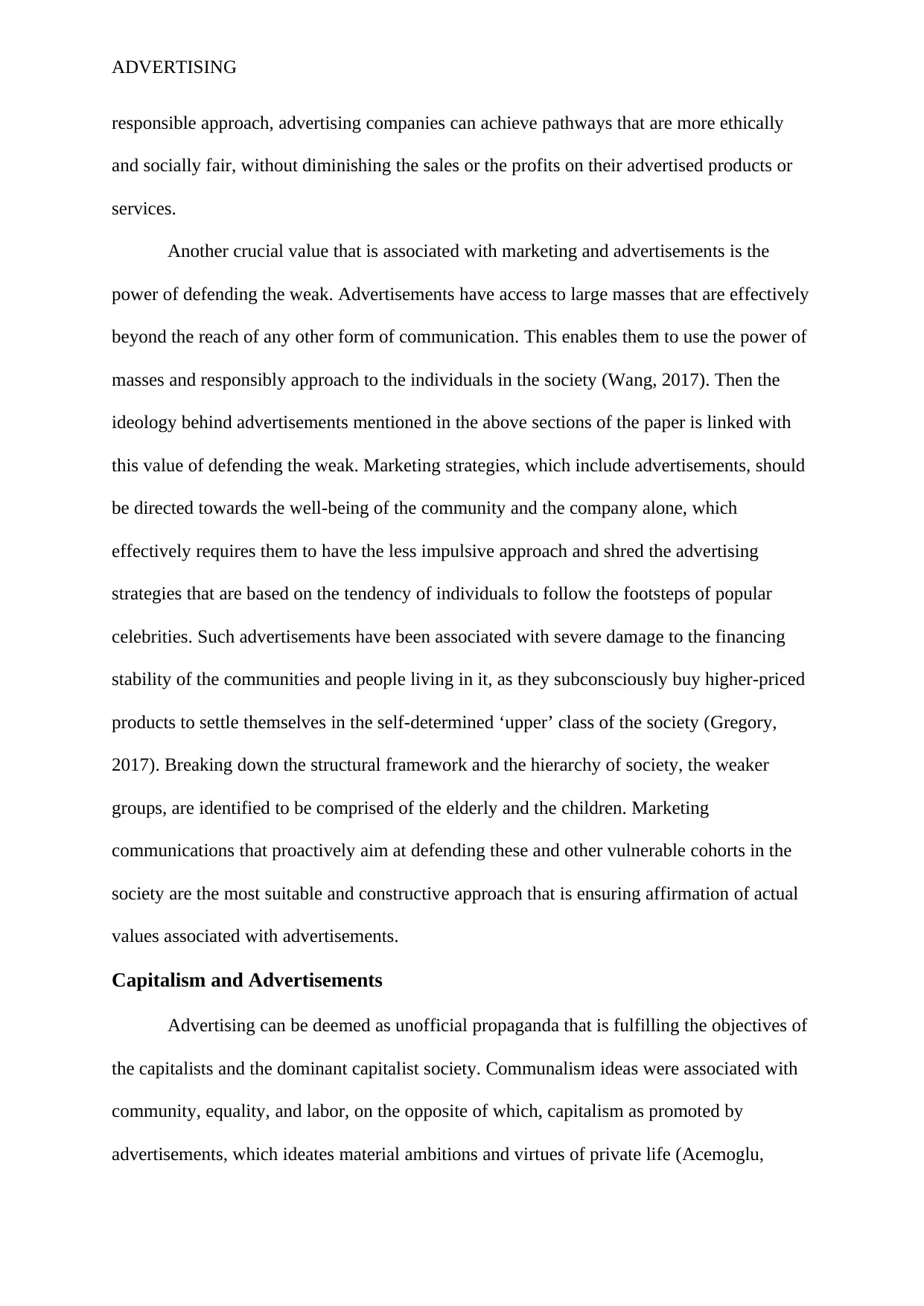
ADVERTISING
responsible approach, advertising companies can achieve pathways that are more ethically
and socially fair, without diminishing the sales or the profits on their advertised products or
services.
Another crucial value that is associated with marketing and advertisements is the
power of defending the weak. Advertisements have access to large masses that are effectively
beyond the reach of any other form of communication. This enables them to use the power of
masses and responsibly approach to the individuals in the society (Wang, 2017). Then the
ideology behind advertisements mentioned in the above sections of the paper is linked with
this value of defending the weak. Marketing strategies, which include advertisements, should
be directed towards the well-being of the community and the company alone, which
effectively requires them to have the less impulsive approach and shred the advertising
strategies that are based on the tendency of individuals to follow the footsteps of popular
celebrities. Such advertisements have been associated with severe damage to the financing
stability of the communities and people living in it, as they subconsciously buy higher-priced
products to settle themselves in the self-determined ‘upper’ class of the society (Gregory,
2017). Breaking down the structural framework and the hierarchy of society, the weaker
groups, are identified to be comprised of the elderly and the children. Marketing
communications that proactively aim at defending these and other vulnerable cohorts in the
society are the most suitable and constructive approach that is ensuring affirmation of actual
values associated with advertisements.
Capitalism and Advertisements
Advertising can be deemed as unofficial propaganda that is fulfilling the objectives of
the capitalists and the dominant capitalist society. Communalism ideas were associated with
community, equality, and labor, on the opposite of which, capitalism as promoted by
advertisements, which ideates material ambitions and virtues of private life (Acemoglu,
responsible approach, advertising companies can achieve pathways that are more ethically
and socially fair, without diminishing the sales or the profits on their advertised products or
services.
Another crucial value that is associated with marketing and advertisements is the
power of defending the weak. Advertisements have access to large masses that are effectively
beyond the reach of any other form of communication. This enables them to use the power of
masses and responsibly approach to the individuals in the society (Wang, 2017). Then the
ideology behind advertisements mentioned in the above sections of the paper is linked with
this value of defending the weak. Marketing strategies, which include advertisements, should
be directed towards the well-being of the community and the company alone, which
effectively requires them to have the less impulsive approach and shred the advertising
strategies that are based on the tendency of individuals to follow the footsteps of popular
celebrities. Such advertisements have been associated with severe damage to the financing
stability of the communities and people living in it, as they subconsciously buy higher-priced
products to settle themselves in the self-determined ‘upper’ class of the society (Gregory,
2017). Breaking down the structural framework and the hierarchy of society, the weaker
groups, are identified to be comprised of the elderly and the children. Marketing
communications that proactively aim at defending these and other vulnerable cohorts in the
society are the most suitable and constructive approach that is ensuring affirmation of actual
values associated with advertisements.
Capitalism and Advertisements
Advertising can be deemed as unofficial propaganda that is fulfilling the objectives of
the capitalists and the dominant capitalist society. Communalism ideas were associated with
community, equality, and labor, on the opposite of which, capitalism as promoted by
advertisements, which ideates material ambitions and virtues of private life (Acemoglu,
⊘ This is a preview!⊘
Do you want full access?
Subscribe today to unlock all pages.

Trusted by 1+ million students worldwide
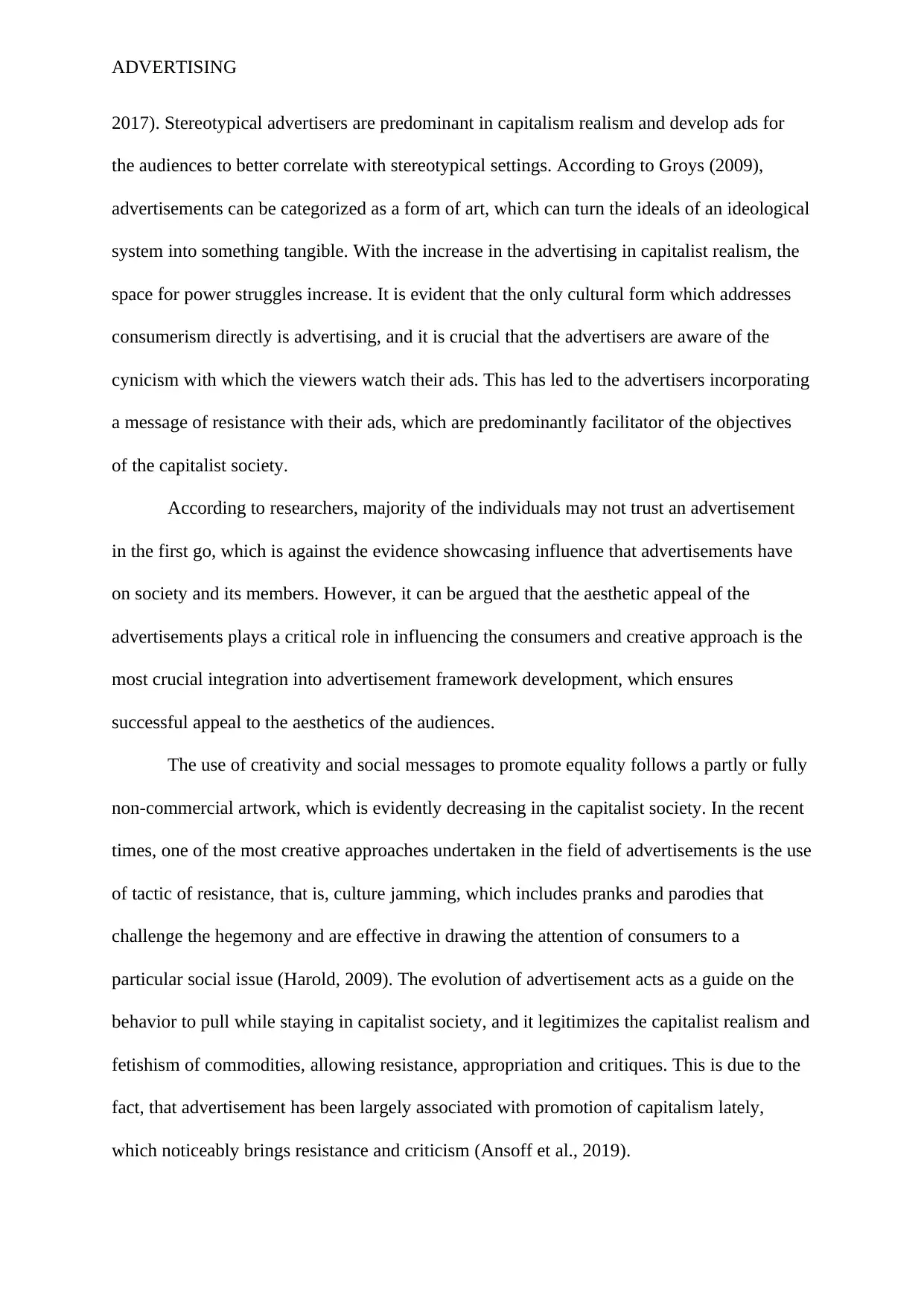
ADVERTISING
2017). Stereotypical advertisers are predominant in capitalism realism and develop ads for
the audiences to better correlate with stereotypical settings. According to Groys (2009),
advertisements can be categorized as a form of art, which can turn the ideals of an ideological
system into something tangible. With the increase in the advertising in capitalist realism, the
space for power struggles increase. It is evident that the only cultural form which addresses
consumerism directly is advertising, and it is crucial that the advertisers are aware of the
cynicism with which the viewers watch their ads. This has led to the advertisers incorporating
a message of resistance with their ads, which are predominantly facilitator of the objectives
of the capitalist society.
According to researchers, majority of the individuals may not trust an advertisement
in the first go, which is against the evidence showcasing influence that advertisements have
on society and its members. However, it can be argued that the aesthetic appeal of the
advertisements plays a critical role in influencing the consumers and creative approach is the
most crucial integration into advertisement framework development, which ensures
successful appeal to the aesthetics of the audiences.
The use of creativity and social messages to promote equality follows a partly or fully
non-commercial artwork, which is evidently decreasing in the capitalist society. In the recent
times, one of the most creative approaches undertaken in the field of advertisements is the use
of tactic of resistance, that is, culture jamming, which includes pranks and parodies that
challenge the hegemony and are effective in drawing the attention of consumers to a
particular social issue (Harold, 2009). The evolution of advertisement acts as a guide on the
behavior to pull while staying in capitalist society, and it legitimizes the capitalist realism and
fetishism of commodities, allowing resistance, appropriation and critiques. This is due to the
fact, that advertisement has been largely associated with promotion of capitalism lately,
which noticeably brings resistance and criticism (Ansoff et al., 2019).
2017). Stereotypical advertisers are predominant in capitalism realism and develop ads for
the audiences to better correlate with stereotypical settings. According to Groys (2009),
advertisements can be categorized as a form of art, which can turn the ideals of an ideological
system into something tangible. With the increase in the advertising in capitalist realism, the
space for power struggles increase. It is evident that the only cultural form which addresses
consumerism directly is advertising, and it is crucial that the advertisers are aware of the
cynicism with which the viewers watch their ads. This has led to the advertisers incorporating
a message of resistance with their ads, which are predominantly facilitator of the objectives
of the capitalist society.
According to researchers, majority of the individuals may not trust an advertisement
in the first go, which is against the evidence showcasing influence that advertisements have
on society and its members. However, it can be argued that the aesthetic appeal of the
advertisements plays a critical role in influencing the consumers and creative approach is the
most crucial integration into advertisement framework development, which ensures
successful appeal to the aesthetics of the audiences.
The use of creativity and social messages to promote equality follows a partly or fully
non-commercial artwork, which is evidently decreasing in the capitalist society. In the recent
times, one of the most creative approaches undertaken in the field of advertisements is the use
of tactic of resistance, that is, culture jamming, which includes pranks and parodies that
challenge the hegemony and are effective in drawing the attention of consumers to a
particular social issue (Harold, 2009). The evolution of advertisement acts as a guide on the
behavior to pull while staying in capitalist society, and it legitimizes the capitalist realism and
fetishism of commodities, allowing resistance, appropriation and critiques. This is due to the
fact, that advertisement has been largely associated with promotion of capitalism lately,
which noticeably brings resistance and criticism (Ansoff et al., 2019).
Paraphrase This Document
Need a fresh take? Get an instant paraphrase of this document with our AI Paraphraser
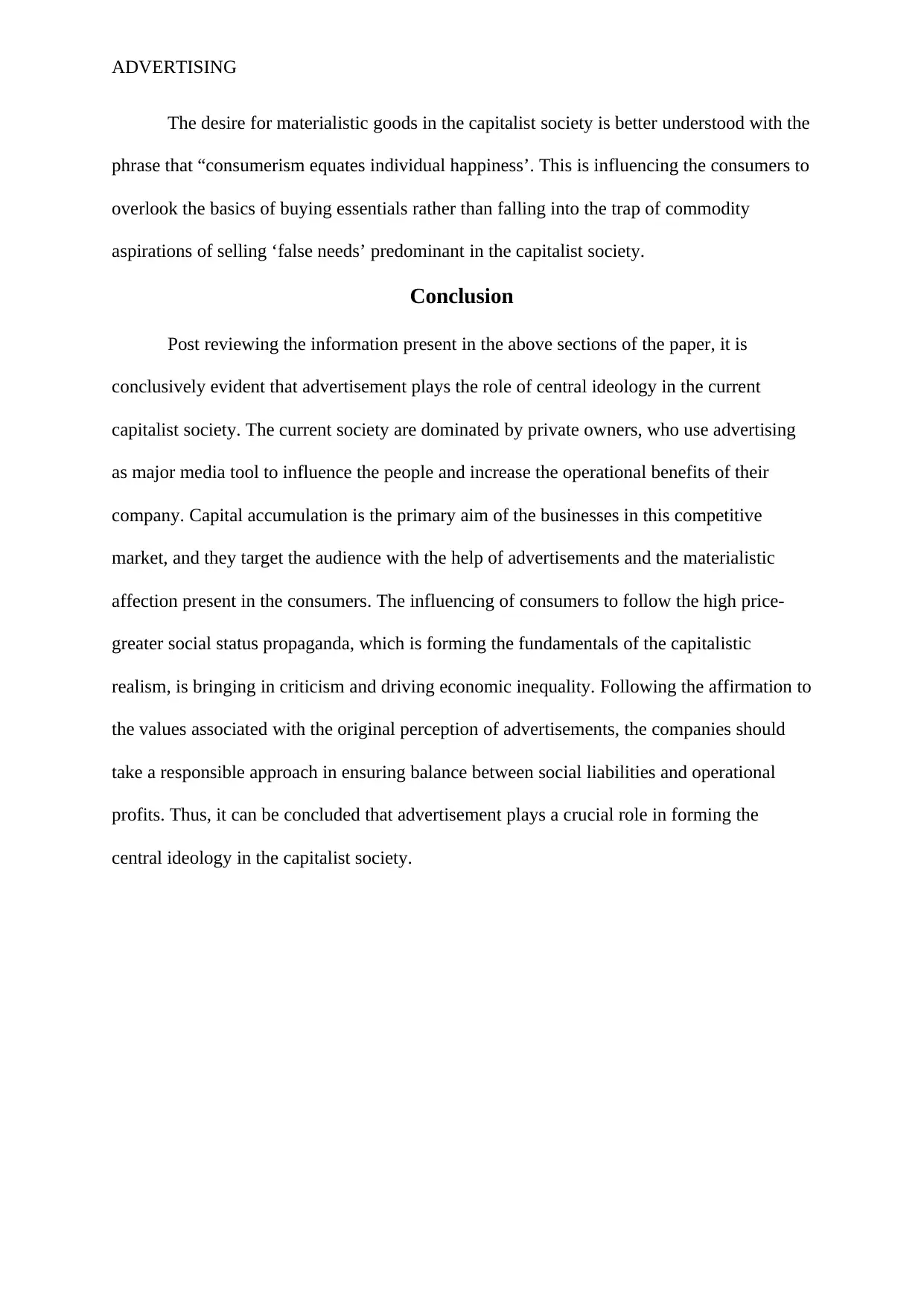
ADVERTISING
The desire for materialistic goods in the capitalist society is better understood with the
phrase that “consumerism equates individual happiness’. This is influencing the consumers to
overlook the basics of buying essentials rather than falling into the trap of commodity
aspirations of selling ‘false needs’ predominant in the capitalist society.
Conclusion
Post reviewing the information present in the above sections of the paper, it is
conclusively evident that advertisement plays the role of central ideology in the current
capitalist society. The current society are dominated by private owners, who use advertising
as major media tool to influence the people and increase the operational benefits of their
company. Capital accumulation is the primary aim of the businesses in this competitive
market, and they target the audience with the help of advertisements and the materialistic
affection present in the consumers. The influencing of consumers to follow the high price-
greater social status propaganda, which is forming the fundamentals of the capitalistic
realism, is bringing in criticism and driving economic inequality. Following the affirmation to
the values associated with the original perception of advertisements, the companies should
take a responsible approach in ensuring balance between social liabilities and operational
profits. Thus, it can be concluded that advertisement plays a crucial role in forming the
central ideology in the capitalist society.
The desire for materialistic goods in the capitalist society is better understood with the
phrase that “consumerism equates individual happiness’. This is influencing the consumers to
overlook the basics of buying essentials rather than falling into the trap of commodity
aspirations of selling ‘false needs’ predominant in the capitalist society.
Conclusion
Post reviewing the information present in the above sections of the paper, it is
conclusively evident that advertisement plays the role of central ideology in the current
capitalist society. The current society are dominated by private owners, who use advertising
as major media tool to influence the people and increase the operational benefits of their
company. Capital accumulation is the primary aim of the businesses in this competitive
market, and they target the audience with the help of advertisements and the materialistic
affection present in the consumers. The influencing of consumers to follow the high price-
greater social status propaganda, which is forming the fundamentals of the capitalistic
realism, is bringing in criticism and driving economic inequality. Following the affirmation to
the values associated with the original perception of advertisements, the companies should
take a responsible approach in ensuring balance between social liabilities and operational
profits. Thus, it can be concluded that advertisement plays a crucial role in forming the
central ideology in the capitalist society.
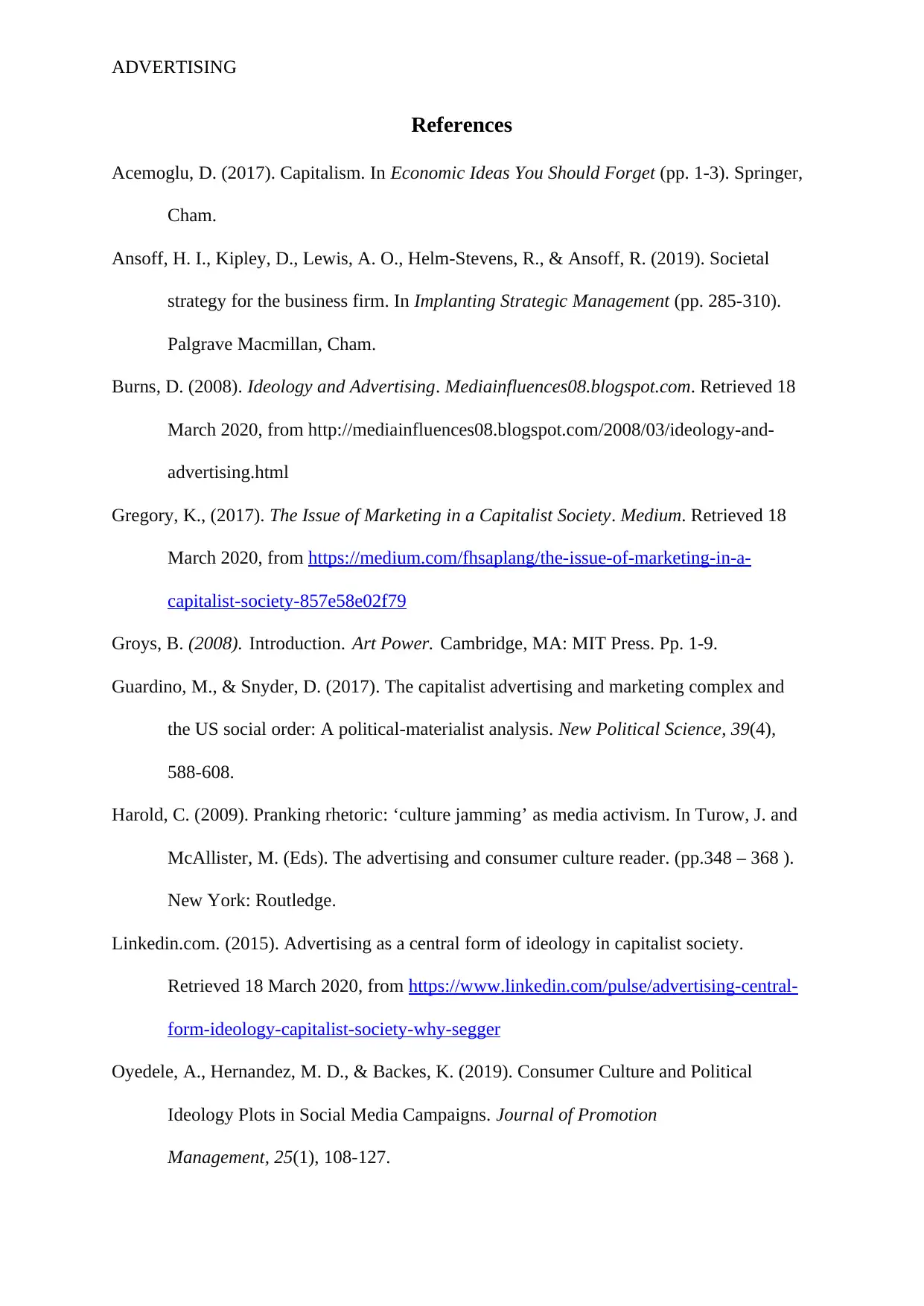
ADVERTISING
References
Acemoglu, D. (2017). Capitalism. In Economic Ideas You Should Forget (pp. 1-3). Springer,
Cham.
Ansoff, H. I., Kipley, D., Lewis, A. O., Helm-Stevens, R., & Ansoff, R. (2019). Societal
strategy for the business firm. In Implanting Strategic Management (pp. 285-310).
Palgrave Macmillan, Cham.
Burns, D. (2008). Ideology and Advertising. Mediainfluences08.blogspot.com. Retrieved 18
March 2020, from http://mediainfluences08.blogspot.com/2008/03/ideology-and-
advertising.html
Gregory, K., (2017). The Issue of Marketing in a Capitalist Society. Medium. Retrieved 18
March 2020, from https://medium.com/fhsaplang/the-issue-of-marketing-in-a-
capitalist-society-857e58e02f79
Groys, B. (2008). Introduction. Art Power. Cambridge, MA: MIT Press. Pp. 1-9.
Guardino, M., & Snyder, D. (2017). The capitalist advertising and marketing complex and
the US social order: A political-materialist analysis. New Political Science, 39(4),
588-608.
Harold, C. (2009). Pranking rhetoric: ‘culture jamming’ as media activism. In Turow, J. and
McAllister, M. (Eds). The advertising and consumer culture reader. (pp.348 – 368 ).
New York: Routledge.
Linkedin.com. (2015). Advertising as a central form of ideology in capitalist society.
Retrieved 18 March 2020, from https://www.linkedin.com/pulse/advertising-central-
form-ideology-capitalist-society-why-segger
Oyedele, A., Hernandez, M. D., & Backes, K. (2019). Consumer Culture and Political
Ideology Plots in Social Media Campaigns. Journal of Promotion
Management, 25(1), 108-127.
References
Acemoglu, D. (2017). Capitalism. In Economic Ideas You Should Forget (pp. 1-3). Springer,
Cham.
Ansoff, H. I., Kipley, D., Lewis, A. O., Helm-Stevens, R., & Ansoff, R. (2019). Societal
strategy for the business firm. In Implanting Strategic Management (pp. 285-310).
Palgrave Macmillan, Cham.
Burns, D. (2008). Ideology and Advertising. Mediainfluences08.blogspot.com. Retrieved 18
March 2020, from http://mediainfluences08.blogspot.com/2008/03/ideology-and-
advertising.html
Gregory, K., (2017). The Issue of Marketing in a Capitalist Society. Medium. Retrieved 18
March 2020, from https://medium.com/fhsaplang/the-issue-of-marketing-in-a-
capitalist-society-857e58e02f79
Groys, B. (2008). Introduction. Art Power. Cambridge, MA: MIT Press. Pp. 1-9.
Guardino, M., & Snyder, D. (2017). The capitalist advertising and marketing complex and
the US social order: A political-materialist analysis. New Political Science, 39(4),
588-608.
Harold, C. (2009). Pranking rhetoric: ‘culture jamming’ as media activism. In Turow, J. and
McAllister, M. (Eds). The advertising and consumer culture reader. (pp.348 – 368 ).
New York: Routledge.
Linkedin.com. (2015). Advertising as a central form of ideology in capitalist society.
Retrieved 18 March 2020, from https://www.linkedin.com/pulse/advertising-central-
form-ideology-capitalist-society-why-segger
Oyedele, A., Hernandez, M. D., & Backes, K. (2019). Consumer Culture and Political
Ideology Plots in Social Media Campaigns. Journal of Promotion
Management, 25(1), 108-127.
⊘ This is a preview!⊘
Do you want full access?
Subscribe today to unlock all pages.

Trusted by 1+ million students worldwide
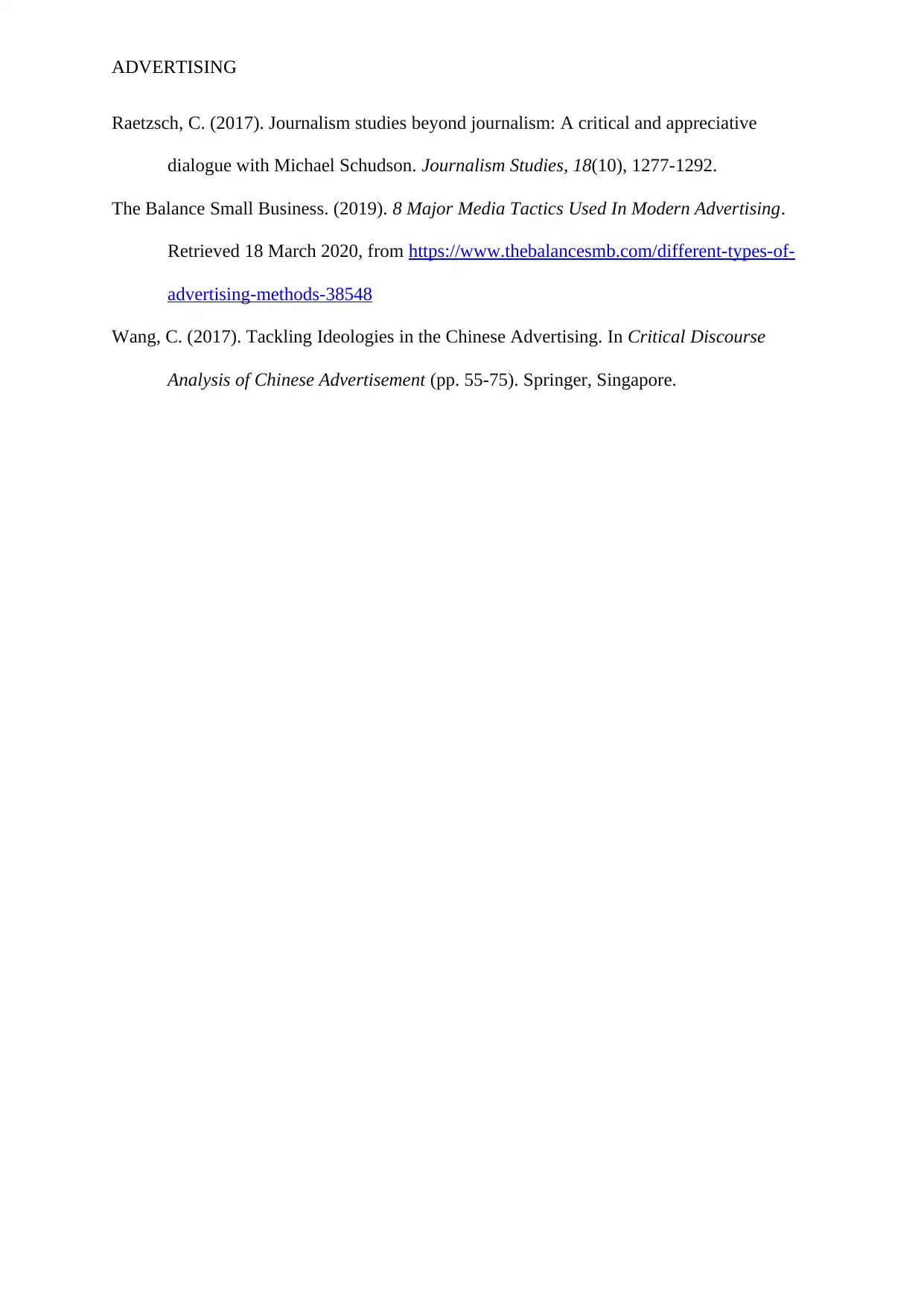
ADVERTISING
Raetzsch, C. (2017). Journalism studies beyond journalism: A critical and appreciative
dialogue with Michael Schudson. Journalism Studies, 18(10), 1277-1292.
The Balance Small Business. (2019). 8 Major Media Tactics Used In Modern Advertising.
Retrieved 18 March 2020, from https://www.thebalancesmb.com/different-types-of-
advertising-methods-38548
Wang, C. (2017). Tackling Ideologies in the Chinese Advertising. In Critical Discourse
Analysis of Chinese Advertisement (pp. 55-75). Springer, Singapore.
Raetzsch, C. (2017). Journalism studies beyond journalism: A critical and appreciative
dialogue with Michael Schudson. Journalism Studies, 18(10), 1277-1292.
The Balance Small Business. (2019). 8 Major Media Tactics Used In Modern Advertising.
Retrieved 18 March 2020, from https://www.thebalancesmb.com/different-types-of-
advertising-methods-38548
Wang, C. (2017). Tackling Ideologies in the Chinese Advertising. In Critical Discourse
Analysis of Chinese Advertisement (pp. 55-75). Springer, Singapore.
1 out of 10
Related Documents
Your All-in-One AI-Powered Toolkit for Academic Success.
+13062052269
info@desklib.com
Available 24*7 on WhatsApp / Email
![[object Object]](/_next/static/media/star-bottom.7253800d.svg)
Unlock your academic potential
Copyright © 2020–2025 A2Z Services. All Rights Reserved. Developed and managed by ZUCOL.



